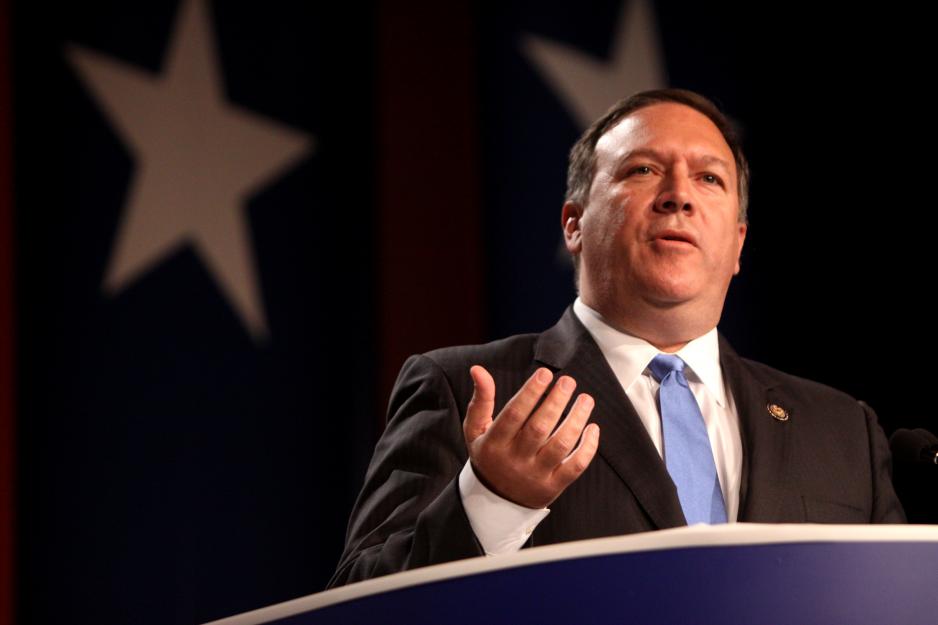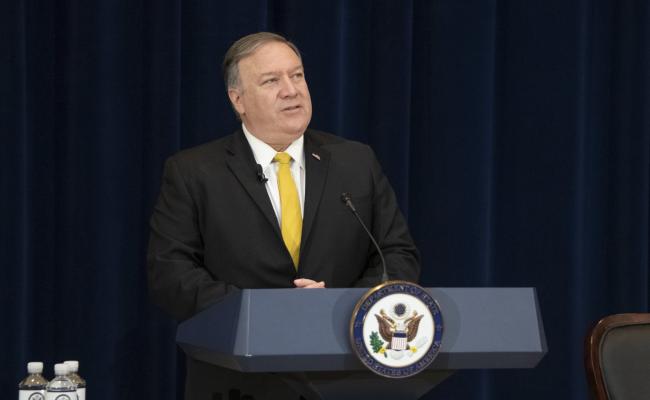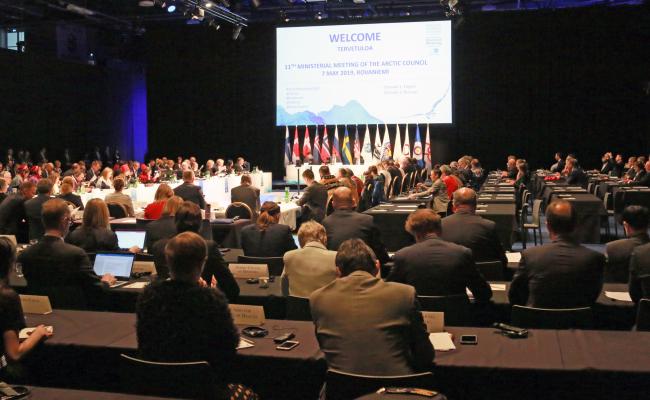Is This the End of the Arctic Council and Arctic Governance as We Know It?

Gjenåpningen av USAs konsulat i Nuuk reflekterer USAs forpliktelse til å styrke samarbeidet med Grønland og Danmark, uttalte USAs utenriksminister Mike Pompeo i en pressmelding onsdag. Foto: Gage Skidmore.
Those of us who deeply care about the Arctic Council and the future of the Arctic should be aware of what is happening and should do our utmost to speak for the values the Arctic Council represents, urges Timo Koivurova, former advisor to the Finnish Chairmanship of the Arctic Council .
For a long time, many of us observing Arctic affairs have been using the term Rovaniemi Arctic spirit when we refer to Arctic international co-operation.[1] It aims to capture the sentiment that it is in this region that Arctic states can foster peace and international co-operation, even if there are tensions between their overall relations. This spirit is now in danger, and I will explain why. As a scholar who has studied the Arctic international co-operation from the mid-1990s, we have now reached a stage where we need to have serious discussions about what is happening in the region – are we losing the Rovaniemi Arctic spirit, and, if so, in what way?
My own experience stems from the Finnish chairmanship of the Arctic Council between 2017 and 2019. Not only did I play multiple roles in implementing that chairmanship, but also I interviewed all the key civil servants and diplomats who were in charge of various aspects of the Finnish chairmanship.
We prepared our chairmanship programme during the United States chairmanship (2015-2017), which was presented already at the Portland Senior Arctic Official meeting (October 2016). Our chairmanship programme very much reflected the ambitious Obama-era priorities of the US chairmanship: along with other goals, we expressed our willingness to implement the Paris climate agreement and the UN Sustainable Development Goals (UN SDGs) via the Arctic Council. Yet, the first challenge was already around the corner. It was not Hillary Clinton who was elected as the President of the United States, but Donald Trump, whose priorities were diametrically opposed to those of the Obama administration. Trump had openly undermined both the Paris climate agreement and multilateral frameworks in general in his campaign.
So, when the Fairbanks ministerial meeting of 11 May 2017 drew near, we found ourselves in a very tricky situation: our chairmanship programme was built on those multilateral frameworks that the Trump administration was thought to oppose. And this did manifest itself in the Fairbanks ministerial meeting. When we, in the Finnish delegation, made our way to Fairbanks, we heard that the then Secretary of State Rex Tillerson had challenged the Fairbanks declaration. This caused a lot of uproar, and diplomats from all the other seven Arctic Council member states were busy trying to convince Tillerson and his aides that the declaration is acceptable. Finally, Tillerson did accept the declaration, and it was ultimately signed, but he did mention in the final plenary that the Trump administration had not yet made up its mind about whether or not to stay in the Paris climate agreement.[2] The good side, from the viewpoint of the Finns, was this: we could commence our chairmanship programme with our stated priorities.
The initial stages of the chairmanship were fairly problem-free but gradually the imprint of the Trump administration started to manifest itself. The US had a very ambitious Arctic Council chairmanship 2015-2017 and had, for example, commenced two initiatives to make the Council a more ambitious and strategic forum: to establish a Marine Commission within the Arctic Council to consolidate the marine policy of the Arctic waters and to adopt the first ever long-term strategy for the Council. Finland, hence, was tasked with completing these projects as the next chair, but unfortunately was unable to finalise either. The United States, which commenced the Marine Commission work, was also one country that was now against establishing the Commission. The long-term strategy work continued until the final stages of Finland’s chairmanship, but there were several reasons why it could not be adopted. Sadly, one of these reasons was that we did not want to have a first-ever long-term strategy for the Council that would not mention climate change.
Finland was also leading the expert group on black carbon and methane, which became a visible activity during our chairmanship, given that our President was actively discussing the issue of black carbon with both Presidents Putin and Trump. Unfortunately, by the end of the work, the US did not accept anymore the collective goal that was agreed in the Fairbanks declaration for black carbon reduction: 25-33% reduction by 2025 from their 2013 emission levels. Furthermore, the US did not perceive the work in this expert group as climate change mitigation but as related to curtailing air pollution, and was generally against referring to multilateral frameworks in this work. Russia, on its part, had difficulties in delivering information to the expert group.
In my own work as the chair of Social, Economic and Cultural Expert Group, an expert group under the Arctic Council’s Sustainable Development Working Group (SDWG), the problem turned out to be the UN SDGs. When I presented our work to the SDWG, at first the US representative said that I can talk of UN SDGs in general, but not of the individual goals of the UN SDGs. Then, in the February 2019 SDWG meeting, the US representative asked me not to refer anymore to the UN SDGs at all.
Hence, when the Rovaniemi ministerial meeting approached, most of us knew that the Trump administration’s values and priorities had started to influence the work of the Arctic Council, but it is also equally clear that we could not foresee what was ahead of us. The US challenge to the work of the Arctic Council had been visible but it was not systematic. Most work in the Council was still going forward relatively well.
Rovaniemi Ministerial Meeting
There were many problems that Finland’s chairmanship faced during the Rovaniemi ministerial meeting ending the Finnish chairmanship. The preparation of the declaration, as usual, was commenced much before the ministerial meeting. During the weekend before the ministerial (6-7 May 2019), the Senior Arctic Officials (SAOs) were able to remove most of the bracketed sentences, and by Sunday, 5 May 2019, the declaration was acceptable to all the eight Arctic states.
Also read
Yet, gradually over that weekend, the US delegation leadership was overtaken by high-level officials from the US State Department. For this reason, few hours after the declaration had been accepted, the US informed that it no longer consents to the declaration, and it proposed its own draft for a declaration, which lacked any references to climate change. This was a vast surprise to other delegations, given that much of the Arctic Council’s work deals directly or indirectly with climate change, and the other states signalled their disapproval of the US proposal. On Monday, the foreign ministers convened in the Arktikum building in Rovaniemi for a dinner, which was the final opportunity for Finland to bridge these two opposing views. Yet, the US was adamant in not having climate change mentioned in the declaration, and the other delegations were equally clear that climate change needs to be mentioned. Hence, Finnish diplomats needed to acknowledge that, realistically, no signed declaration can be achieved.
This started a busy period of coming up with a solution on how to save the Rovaniemi ministerial meeting and continue the work of the Arctic Council. Finland’s solution was based on the already existing declaration and was two-fold: signing a joint statement by all the eight Arctic states, which welcomed the Icelandic chairmanship and its chairmanship programme, and a statement by the chair (foreign minister of Finland) as to what was agreed in the meeting and what was not. Yet, this was not the end of the challenge from the US viewpoint. The US delegation was also not ready to adopt the SAO report as it contained a lot of references to climate change, and it asked Finland to remove it from the agenda of the plenary. Why is this report so important? It contained the working plans of all six working-groups of the Arctic Council and also the budget of the Council secretariat. Finland took a conscious risk and placed it on the agenda of the ministerial meeting, just before the signing of the joint ministerial statement, thinking that the US would not dare to challenge the consensus. This strategy proved successful, and the US did not object to the SAO report in the plenary of the ministerial.
These events lead to serious questions. Was there a real challenge to the further functioning of the Arctic Council? No. The US did welcome the short signed ministerial statement, in which the Icelandic chairmanship and chairmanship programme were approved. Yet, it did object to the acceptance of the SAO report, which was meant to guarantee the continuation of work-plans of the working-groups and secure the budget for the Arctic Council secretariat. This was a real challenge since no one was able to tell at the time how we could continue the work of the working-groups, as normally these are authorised by a signed declaration (but now they were not). This needs to be kept in mind, even if ultimately the SAO report was accepted.
Also read
Why did the ministerial meeting then become such a dramatic event? As I already mentioned, there were some signs of Trump administration priorities starting to influence the views and behaviour of few US officials during the Finnish chairmanship. Yet, clearly the bigger challenge came from the fact that the US delegation leadership changed just before the ministerial, which then led to greater challenges in the ministerial meeting. It did seem that this new leadership was not much aware of what the Arctic Council does, which then, in part, led to significant problems in keeping the Arctic Council going.
Threats to Arctic Governance aired out during the Rovaniemi Ministerial Meeting
Surprisingly, the Secretary of State Mike Pompeo wanted to give an unscheduled presentation on 6 May, just before the actual ministerial meeting in the same hockey arena where the ministerial meeting would take place the next day. I think most of us who were invited to hear this speech were also surprised about its aggressive tone. Pompeo aired out the Trump administration’s concerns towards both China and Russia. He perceived that China’s behaviour needs to be carefully monitored because, according to him, China will likely be as dubious an actor in the Arctic as it has been elsewhere. He also argued that China is already a military threat in the Arctic and will only be more so in the future. For Pompeo, Russia also poses a threat, given that it has militarised its Arctic regions and has enacted an illegal decree to impede navigation along the Northern Sea Route. The tone of his speech was aggressive, and he advanced the Arctic not as a place for peaceful co-operation but one of strategic competition. These views have been confirmed by the then national security adviser Bolton and President Trump himself.
What is the Future of the Arctic Council and Arctic Governance?
What is then left of the Rovaniemi Arctic spirit that we have been able to celebrate from the time after the end of the Cold War up until now?
What will happen with the Arctic Council? Perhaps it can continue as before, now that all the important documents have been adopted by the Rovaniemi ministerial. The first signs from the Icelandic chairmanship are bright, things are moving well, but so they were even at the beginning of the Finnish chairmanship. Yet, now that we know that US officials were implementing the Trump agenda during the Finnish chairmanship and that the US did not accept climate change even mentioned during the ministerial meeting, it is difficult to maintain that nothing has changed (at least until the end of Trump presidency). It is a fact that the Trump administration is against exactly those climate change and multilateral frameworks that are at the core of how the Arctic Council functions.
What will be important is who will be nominated as the next SAO of the US, as currently there is an interim SAO. It is not even sure that a regular SAO will be nominated, but if this does take place and if this person is close to Trump administration (as one can suspect), this nomination would have a wider impact on the functioning of the Arctic Council. This is because it is the SAOs that co-ordinate all the work within the Arctic Council.
It is also important to highlight the importance of the results of the next Presidential elections in the US in November 2020. If a Democrat wins, it is likely that the functioning of the Arctic Council will be restored to normal, indicating how much the current challenge to the Arctic Council and Arctic governance is related to Trump himself. If Trump wins the re-election, it seems quite likely that the Council will also change. It is difficult to foresee that if Trump gets another 4 years continuation for his Presidency, climate change work in the Arctic Council could continue. In this scenario, it is more likely that the Council gradually focuses more on traditional environmental protection and sustainable development, with a heavy tilt towards advancing economic opportunities in the region. What will then happen with the climate change work of the Council? It is my belief that this will continue in other international co-operation forums that are plentiful in the Arctic, science and university organisations but also in other intergovernmental forums where the US is not a member, such as the Nordic Council or the Barents Euro-Arctic Council. I do think that, in this scenario, other Arctic Council member states would see it more important to continue Council co-operation than pulling out of it because of obstacles to continue climate change work.
What about the future direction of Arctic international governance in general? – after all, the Arctic Council is only part and parcel of the larger governance framework of the region. For long, we have been defining the Arctic as an exceptional area, a region to which the general tensions of the major powers will mostly not extend. This has been a longstanding policy of all Arctic states – to keep the Arctic outside these tensions and build collaborative structures to advance sustainable development in the region. A good example of this is the Ukraine controversy and conflict. All the other Arctic Council member states participated in sanctions against Russia, and Russia counter-sanctioned. Yet, this did not prevent the Arctic and other actors from building further international co-operation – the Arctic Council functioned fine, and produced a new legally binding agreement on scientific co-operation in 2017; the Polar Code entered force in 2017; and the Central Arctic Ocean Fisheries agreement was signed in 2018.
Yet, now we have an Arctic Council member state, USA, which openly challenges Russia and wants to fight its global “war” with China also in the Arctic. The US also denies the existence of climate change, even if it clearly is the biggest threat to the future of the Arctic and forms a main part of the work that the Arctic collaborative arrangements focus on. It is because of this change in the geopolitical situation that, at the last Arctic Circle, the Prime Ministers of Finland and Iceland were discussing whether we should include hard security issues in the agenda of the Arctic Council – and at least the Icelandic premier seemed to be of that opinion. The US tries to portray the Arctic as a place for strategic competition, which works against the image most of us have had of the region – that of being a place for peace and international co-operation. Mostly the US has moved forward with heavy words, rather than actions, and we have to see how serious the Trump administration is in its Arctic actions. But words also matter. The world’s only superpower can create realities simply by re-stating what is happening in the Arctic, in its own view, however wrongly it would capture the reality of the region. If this were to become the perceived reality of the region, we may still have international cooperation and the Arctic Council functioning in the region, but their importance would diminish.
Concluding Note
It is, hence, difficult to conclude in any other way than to say that there are grave uncertainties as to how the Arctic Council and Arctic international governance in general will develop. We know that the Arctic Council and Arctic governance will continue to face serious challenges as long as Trump remains the President of the United States. The framework of Arctic governance will be put into a test of resilience – how can climate change work continue when the US does not even want to have that term in a declaration, or wants to portray the region as a place for strategic competition? Will we, 10 years from now, recall that it was the Rovaniemi Arctic Council ministerial meeting where we lost the Rovaniemi Arctic spirit that was triggered in that very same town. Those of us who deeply care about the Arctic Council and the future of the Arctic should be aware of what is happening and should do our utmost to speak for the values the Arctic Council represents.
This piece originally appeared on The Polar Connection. Republished with permission.




